Developing upper body strength is essential for maintaining an overall healthy and strong physique, as well as supporting daily activities that require upper body muscle engagement. This article will guide you through the fundamentals of upper body strength exercises, covering topics like basic anatomy, exercise techniques, various types of exercises, workout routines, and more. By the end of this article, you will have the knowledge and tools necessary to begin your journey towards a more robust and powerful upper body.
Basic anatomy and muscle groups of the upper body
The upper body consists of several key muscle groups that contribute to our ability to perform various movements and tasks. Developing a strong upper body can not only improve your physical appearance, but it can also help with daily tasks and potentially reduce the risk of injury. To help you better understand these muscle groups and how they function, we have provided a brief overview below.
Chest (Pectorals)
The chest is mainly comprised of the pectoralis major and pectoralis minor muscles. The pectoralis major is the larger, more superficial muscle, which is responsible for movements such as pushing and pressing. The pectoralis minor, which is beneath the pectoralis major, helps with scapular movement and stabilization.
Back
The back hosts several muscle groups, including:
- Latissimus dorsi – Also known as ‘lats,’ these muscles are the largest in the back, and are responsible for shoulder extension, adduction, and internal rotation. They contribute to activities like pulling and swimming.
- Trapezius – The trapezius muscles are large and triangular, extending from the base of the skull down to the middle of the back. They help with shoulder elevation, retraction, and rotation, as well as neck movement.
- Rhomboids – The rhomboid major and rhomboid minor help with scapular retraction and work together with the trapezius muscles to maintain proper posture.
Shoulders (Deltoids)
The shoulders are made up of three separate heads of the deltoid muscle – the anterior (front), medial (middle), and posterior (rear) deltoids. These muscles help with various shoulder movements, such as flexion, extension, abduction, and rotation.
Arms
- Biceps – The biceps brachii, located on the front of the upper arm, are responsible for elbow flexion, forearm supination (rotation), and weak shoulder flexion.
- Triceps – The triceps brachii are located at the back of the upper arm. These muscles are responsible for elbow extension and assist in shoulder extension.
- Forearms – The forearm muscles are divided into two groups: flexors and extensors. Flexor muscles, located on the inner side of the forearm, are responsible for wrist and finger flexion. Extensor muscles, located on the outer side of the forearm, are responsible for wrist and finger extension.
Now that you have a basic understanding of the major muscle groups in the upper body, you can start incorporating strength exercises targeting these areas. Some common upper body exercises include push-ups, pull-ups, bench press, shoulder press, rows, bicep curls, and tricep dips. Remember to start slow, maintain proper form, and progressively increase the intensity of your workouts as your strength improves.
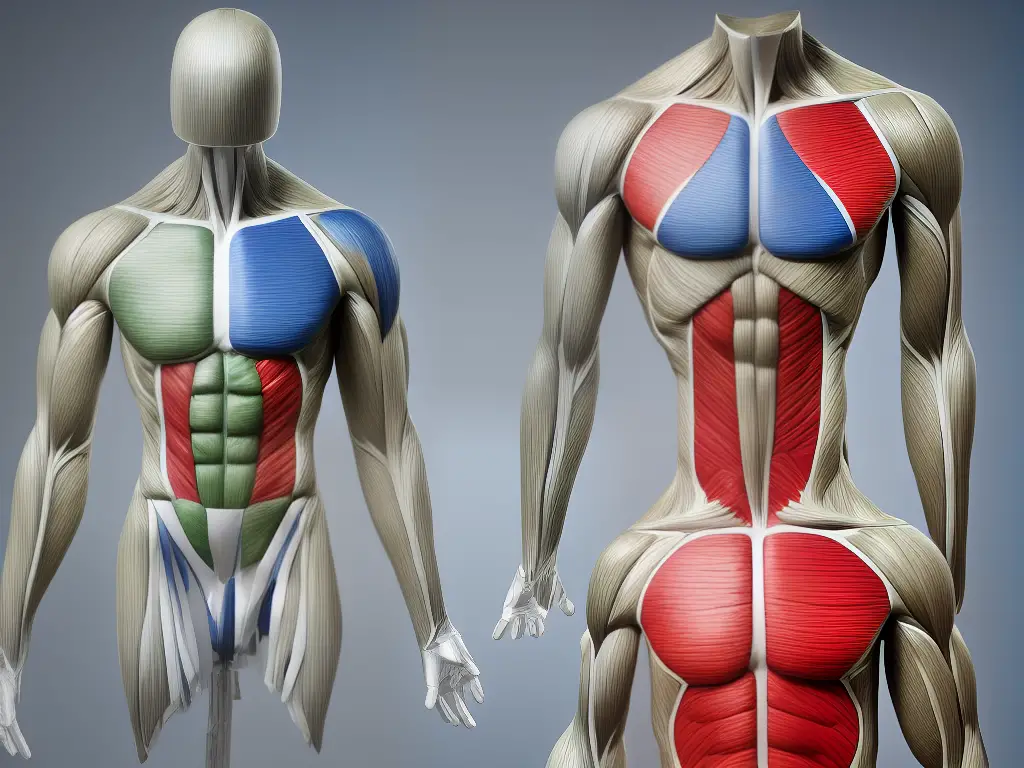
Proper exercise form and technique
Developing upper body strength is essential for improving daily functionality and overall health. By following proper form and technique, you can ensure that you are exercising efficiently while minimizing the risk of injury. Here is a breakdown of some common upper body strength exercises, along with instructions on proper exercise form and technique.
1. Push-ups:
- Begin in a plank position, with your hands slightly wider than shoulder-width apart, and your body in a straight line from your head to your heels.
- Engage your core muscles and lower your chest towards the floor by bending your elbows.
- Keep your elbows close to your sides and your head neutral, maintaining a straight line with your spine.
- Push back up to starting position using your chest and arm muscles.
- Aim for 3 sets of 12-15 repetitions, resting for 30-60 seconds between sets.
2. Pull-ups:
- Find a sturdy pull-up bar and stand underneath it. Reach up and grasp the bar with an overhand grip, hands slightly wider than shoulder-width apart.
- Hang from the bar with your arms fully extended, keeping your shoulders engaged and down (avoid shrugging).
- Pull yourself up towards the bar, focusing on engaging your back and bicep muscles.
- Try to bring your chest to the bar while keeping your elbows close to your body; avoid swinging or using momentum.
- Lower yourself back down with control, keeping your core engaged throughout the whole movement.
- Aim for 3 sets of 5-10 repetitions, resting for 60-120 seconds between sets.
3. Dumbbell Bench Press:
- Lay on a flat bench with a dumbbell in each hand, palms facing away from your body.
- With your feet firmly on the ground, lift the dumbbells to the sides of your chest at shoulder height. This is your starting position.
- Press the dumbbells upwards, extending your arms until they are straight.
- Maintain a slight bend in your elbows at the top to avoid hyperextension.
- Slowly lower the dumbbells back to the starting position, controlling the descent.
- Aim for 3 sets of 10-12 repetitions, resting for 60-90 seconds between sets.
4. Bent-over Rows:
- Stand with your feet shoulder-width apart and hold a dumbbell in each hand, palms facing your body.
- Bend your knees slightly and lean forward from your hips, keeping your back straight.
- Position the dumbbells beneath your chest with your arms extended.
- Use your back muscles to pull the weights up towards your chest, keeping your elbows close to your body.
- Squeeze your shoulder blades together at the top of the movement, then lower the dumbbells slowly and with control.
- Aim for 3 sets of 12-15 repetitions, resting for 60-90 seconds between sets.
Proper exercise form and technique are crucial for preventing injuries and maximizing the effectiveness of your upper body strength exercises. Focus on engaging the correct muscles, maintaining good posture, and controlling the movement throughout each exercise. Consult with a fitness professional if you are unsure of your form or have any concerns about specific exercises or movements.
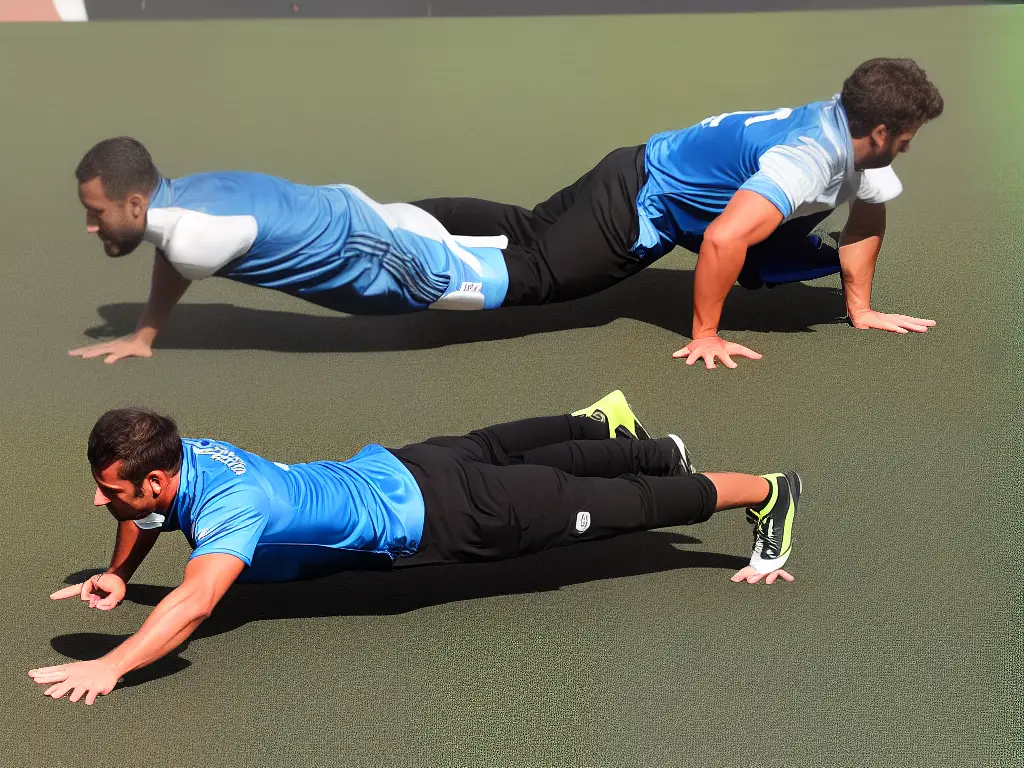
Bodyweight exercises
Bodyweight exercises are a great way to develop upper body strength without the need for any fancy equipment. You can perform these exercises at home, in a park, or in any open space. In this guide, we will explore push-ups, pull-ups, dips, and inverted rows as effective exercises for building upper body muscle.
1. Push-Ups:
Push-ups target your chest, triceps, and shoulders while also engaging your core.
- Start in a plank position with your hands beneath your shoulders, fingers facing forward, and your feet hip-width apart.
- Lower your body by bending your elbows, keeping them close to your body as you descend. Ensure your body forms a straight line from head to heels.
- Once your chest is just above the ground, push yourself back up to the starting plank position.
- Aim for 3 sets of 10-15 repetitions.
2. Pull-Ups:
Pull-ups are a classic bodyweight exercise that targets your back, biceps, and forearms.
- Find a sturdy horizontal bar that can support your body weight. You can use a dedicated pull-up bar, a sturdy tree branch, or monkey bars at a park.
- Grab the bar with both hands using an overhand grip (palms facing away from your body), keeping your hands shoulder-width apart.
- Hang from the bar with your arms fully extended and feet off the ground.
- Slowly pull your body up towards the bar, keeping your core engaged and squeezing your shoulder blades together.
- Continue pulling until your chin is above the bar.
- Lower your body back down to the starting position with control.
- Aim for 3 sets of 5-10 repetitions.
3. Dips:
Dips primarily target your triceps, but also engage your chest and shoulders.
- Find a pair of parallel bars, such as dip bars, or the bars of a sturdy park bench.
- Grip the bars with your palms facing your body and extend your arms so that your body is lifted off the ground.
- Lower your body by bending your elbows, keeping them close to your body. Your elbows should form a 90-degree angle at the bottom of the movement.
- Push yourself back up by extending your arms until they are straight, returning to the starting position.
- Aim for 3 sets of 8-12 repetitions.
4. Inverted Rows:
Inverted rows are a versatile exercise that focuses on your back, shoulders, and biceps.
- Find a horizontal bar that is waist height or slightly lower.
- Lie on your back under the bar, and grasp it with an overhand grip, keeping your hands shoulder-width apart.
- Position your body in a straight line from your head to your heels, with your feet flat on the ground and your hips lifted.
- Pull your chest towards the bar by engaging your back muscles and bending your elbows.
- Lower yourself back down with control, maintaining the straight body position.
- Aim for 3 sets of 8-12 repetitions.
Remember to always warm up before performing these exercises and focus on proper form to avoid injury. Gradually increase the number of sets and repetitions as you become stronger. By consistently including these bodyweight exercises in your routine, you will effectively develop upper body strength.
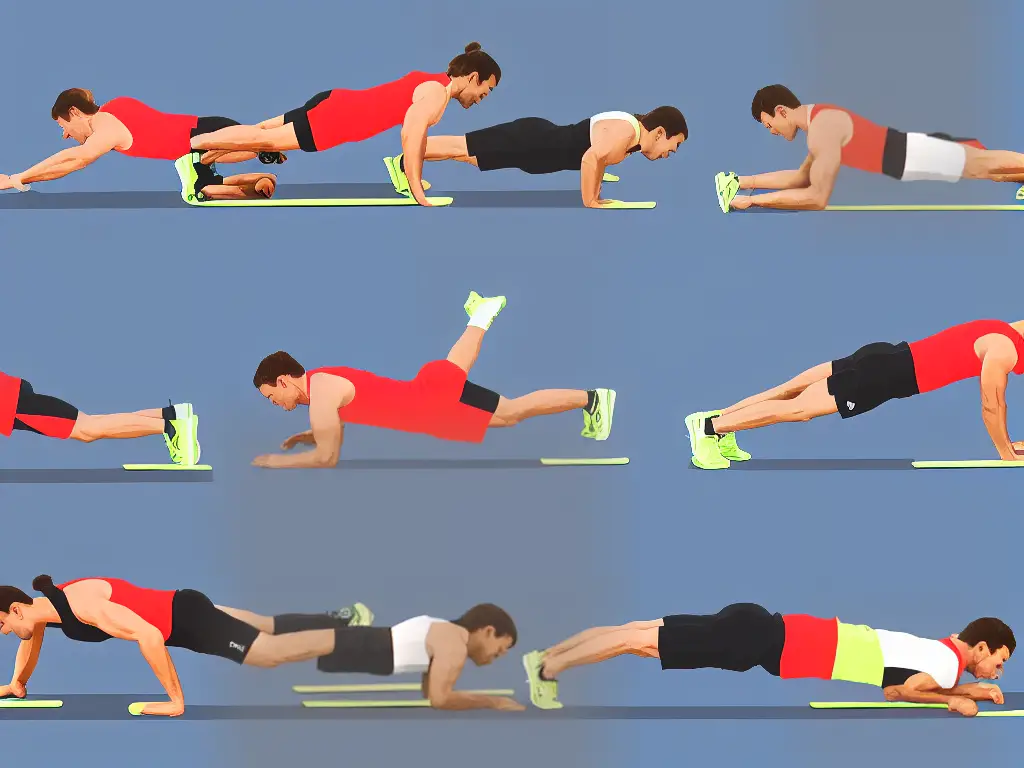
Free weight exercises
The following are four exercises that can be performed with free weights to strengthen the upper body muscles:
Bench Presses
- Targets chest, shoulders, and triceps
- Use a barbell
- Lie down on the bench with feet on the ground and eyes under the bar
- Grab the bar with a medium-width grip and retract your shoulder blades
- Lift the bar off the rack with arms extended above the chest
- Lower the bar to chest level while inhaling
- Raise the bar to the starting position with chest and triceps while exhaling
Overhead Presses
- Targets shoulders and triceps
- Use dumbbells
- Stand with feet shoulder-width apart and hold dumbbells at shoulder level with elbows bent and palms facing forward
- Press dumbbells overhead while inhaling
- Lower the dumbbells slowly while exhaling to starting position
Bent-Over Rows
- Targets back, biceps, and shoulders
- Use a barbell
- Stand with feet hip-width apart and hold the barbell with a medium-width grip, palms facing you
- Bend your knees slightly and hinge forward at the hips, keeping your back straight and chest lifted
- Bring the barbell to your lower chest, keeping your elbows close to the body
- Slowly lower the barbell to starting position
Bicep Curls
- Targets biceps and forearms
- Use dumbbells
- Stand with feet shoulder-width apart and hold a dumbbell in each hand with palms facing forward
- Bend your elbows and curl the dumbbells towards your shoulders
- Slowly lower the dumbbells to starting position
Remember to properly warm up before engaging in these exercises, maintain proper form, and choose a weight that is suitable for your fitness level. Consider working with a certified personal trainer if you are new to free weight exercises to ensure safety and proper technique.
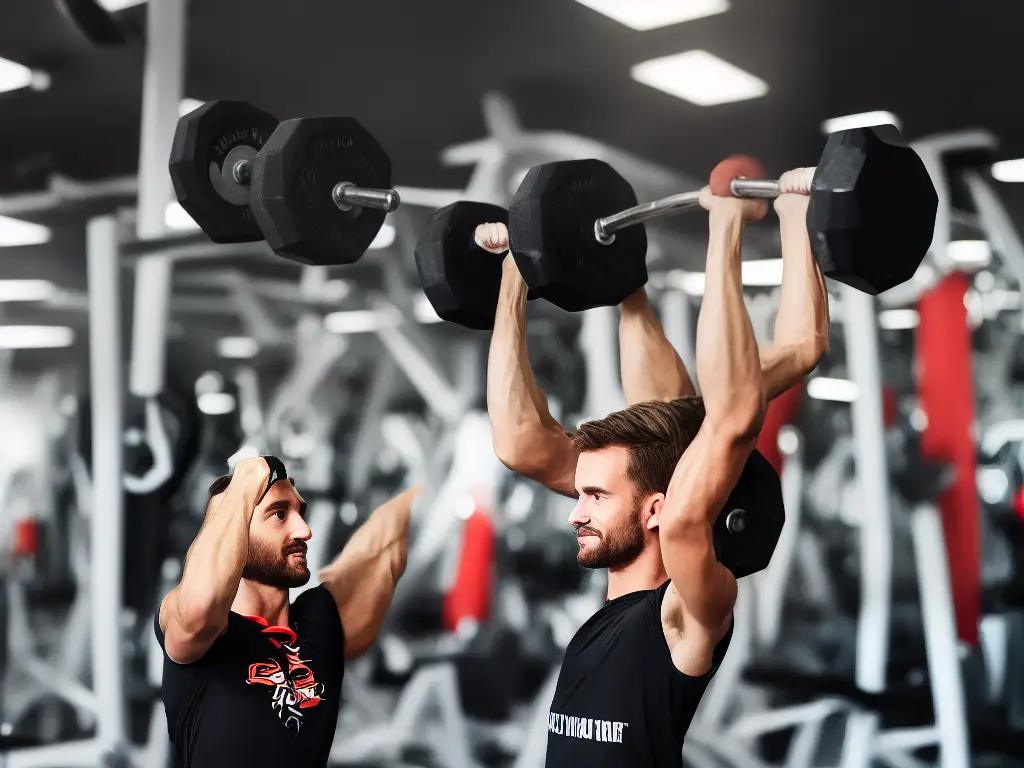
Resistance band exercises
I’m glad you’re interested in learning about resistance band exercises for upper body strength! Resistance bands are a fantastic tool for at-home workouts, as they are budget-friendly, versatile, and easy to store. Here’s a guide on how to perform some popular upper body exercises with resistance bands:
Chest Press
- Loop the resistance band around a sturdy post, like a tree or a pole, at chest height.
- Stand facing away from the post with one end of the band in each hand.
- Keep your elbows bent at a 90-degree angle, with palms facing down, and hands at chest level.
- Push your hands forward, fully extending your arms and engaging your chest muscles.
- Slowly return to the starting position, maintaining constant tension on the band.
- Perform 3 sets of 10-12 repetitions.
Rows
- Sit down on the ground with your legs straight out in front of you.
- Loop the resistance band around your feet, holding one end of the band in each hand.
- Sit up straight and engage your core muscles, keeping your back straight.
- Initiate the movement by pulling your elbows back and squeezing your shoulder blades together.
- Slowly release the tension, gently returning to the starting position.
- Perform 3 sets of 10-12 repetitions.
Shoulder Press
- Step on the middle part of the resistance band with your feet shoulder-width apart.
- Hold either end of the band in your hands, with your palms facing forward and elbows bent.
- Press your hands up and above your head until your arms are fully extended.
- Slowly lower your hands back to the starting position, keeping the tension on the band throughout the movement.
- Perform 3 sets of 10-12 repetitions.
Bicep Curls
- Stand on the middle of the resistance band with your feet hip-width apart.
- Grasp the ends of the band with arms extended by your sides and palms facing forward.
- Bend your elbows and curl your hands toward your shoulders, keeping your upper arms stationary and your elbows close to your body.
- Slowly straighten your arms back to the starting position, maintaining constant tension on the band.
- Perform 3 sets of 10-12 repetitions.
As with any exercise routine, warm up before you begin, and stretch at the end of each session. Make sure you find a resistance band with an appropriate level of resistance for your current strength, and as you progress, you can increase the resistance for a more challenging workout. Remember to maintain proper form and control throughout each movement, and have fun incorporating these exercises into your fitness routine!
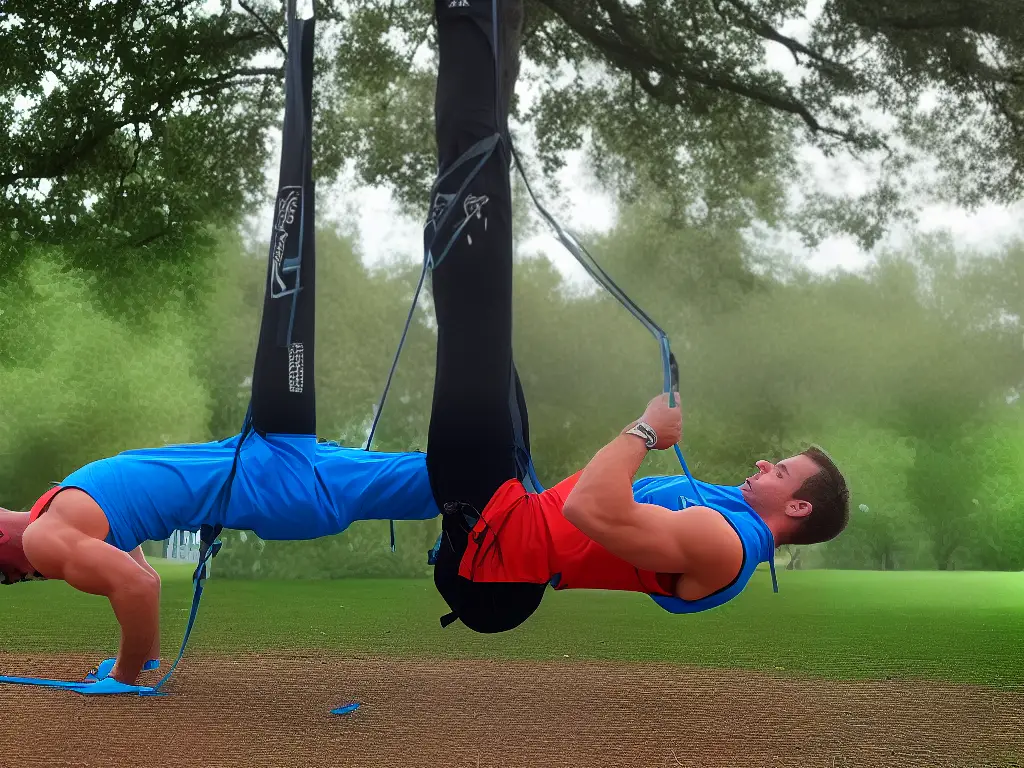
Creating a balanced workout routine
To create a balanced workout routine, it’s important to target all the major muscle groups in the upper body. This will ensure you develop your muscles evenly and prevent imbalances, which can lead to injury or a disproportionate appearance. Follow these steps to design an effective and balanced upper body workout routine:
1. Identify muscle groups:
The major muscle groups in the upper body include the chest, back, shoulders, and arms (biceps and triceps). Smaller muscle groups like the forearms and traps should also be considered for a well-rounded routine.
2. Choose exercises for each muscle group:
Select at least one exercise per muscle group that effectively targets the specific muscles. For example, chest workouts often include pushups or bench presses, while back workouts may feature pull-ups or rows. Here are some examples for each major muscle group:
- Chest: push-ups, bench press (barbell or dumbbell), chest flys
- Back: pull-ups, rows (barbell, dumbbell, or cable), lat pull-downs
- Shoulders: overhead press (barbell or dumbbell), lateral raises, front raises
- Arms: bicep curls (dumbbell or cable), tricep dips, skull crushers
3. Arrange your workout layout:
Begin by organizing your exercises into a workout program. You can do this in one of two ways: a total upper body workout on dedicated days or by splitting your routine into different muscle group-focused days (e.g., chest and triceps on Mondays, back and biceps on Wednesdays, and shoulders on Fridays).
4. Determine sets and repetitions:
For each exercise, decide on the number of sets and repetitions you will perform. A general guideline is to perform 3-4 sets of 8-12 reps per exercise. However, you can adjust these numbers based on your goals (e.g., more sets and lower reps for strength, higher reps for endurance).
5. Warm-up and stretching:
Begin each workout session with a light cardio warm-up (such as jumping jacks or a short jog) and some dynamic stretching to prepare your muscles for exercise. After your workout, take a few minutes to cool down with some static stretching to help improve flexibility and prevent injury.
6. Progression and variety:
In order to continue seeing progress, it’s important to mix up your workouts every few weeks by introducing new exercises or changing up the sets and reps. You can also progress by increasing the weight you are using or by experimenting with more advanced exercise variations.
7. Rest and recovery:
Make sure to give your muscles time to recover between workouts. Aim for at least 48 hours of rest between upper body workout sessions. Adequate sleep, nutrition, and hydration are also crucial for optimal recovery and results.
Here is a sample upper body workout routine based on a total upper body workout approach:
Warm-up: 5-10 minutes of light cardio and dynamic stretching
- Bench press (chest) – 3 sets of 10 reps
- Pull-ups (back) – 3 sets of 8 reps (or as many as possible)
- Overhead press (shoulders) – 3 sets of 10 reps
- Dumbbell rows (back) – 3 sets of 12 reps per arm
- Push-ups (chest) – 3 sets of 12-15 reps (or as many as possible)
- Bicep curls (arms) – 3 sets of 10 reps
- Tricep dips (arms) – 3 sets of 12 reps
- Lateral raises (shoulders) – 3 sets of 12 reps
Cooldown: 5 minutes of light cardio and static stretching
Remember to listen to your body and always practice proper form throughout your exercises. If you’re new to fitness or have any medical concerns, make sure to consult with a fitness professional or your healthcare provider before starting a new workout program.

Importance of rest and recovery
Rest and recovery play a critical role in muscle growth and strength development, especially when you are focusing on upper body strength exercises. In order to see progress and achieve your fitness goals, it’s crucial to understand and implement proper rest and recovery practices alongside your workout routine. This includes proper sleep, nutrition, and stretching.
Sleep:
Adequate sleep is necessary for muscle growth and overall recovery. During sleep, the body produces human growth hormone (HGH), which helps repair muscle tissues, build strength, and improve muscle functionality. Aim for at least 7-9 hours of consistent and quality sleep each night.
Tips for Better Sleep:
- Set a sleep schedule: Go to bed and wake up at the same time every day, even on weekends.
- Create a bedtime routine: Establish a routine that helps you wind down, such as reading, taking a warm shower, or practicing mindfulness meditation.
- Limit stimulating activities before bedtime: Avoid screens, caffeine, and intense exercise close to bedtime.
Nutrition:
Proper nutrition is essential for providing the necessary nutrients for muscle repair and growth. Focus on a balanced diet rich in lean proteins, healthy fats, and complex carbohydrates to fuel your body for upper body strength exercises.
- Protein: A vital nutrient for muscle repair and growth. Include foods such as lean meats, fish, eggs, dairy products, soy, and legumes in your diet.
- Carbohydrates: Provide energy needed for intense exercises. Opt for complex carbohydrates like whole grains, fruits, and vegetables.
- Healthy fats: Promote hormone production and overall health. Include sources such as avocado, nuts, seeds, and fatty fish.
- Stay hydrated: Drink plenty of water throughout the day to avoid dehydration, which can hinder muscle recovery.
Active Recovery and Stretching:
Incorporating active recovery days, as well as flexibility and mobility exercises, is crucial for preventing injuries and promoting muscle recovery.
- Active rest: On rest days, engage in light activities or exercises that keep you moving without putting excessive stress on your muscles, such as walking, swimming, or yoga.
- Stretching: Regular stretching can help improve flexibility and reduce muscle tightness, assisting in muscle recovery. Perform gentle stretches for the upper body, including the chest, back, shoulders, and arms, both before and after your workout.
- Foam rolling: Utilize foam rolling for myofascial release, which can help alleviate muscle soreness and promote recovery. Focus on the specific muscle groups targeted during your upper body strength exercises.
Incorporating adequate rest and recovery practices will not only help you achieve your upper body strength goals but also support overall health and well-being. By getting proper sleep, maintaining a balanced diet, and engaging in active recovery and stretching, you’re setting yourself up for long-term success in your fitness journey.
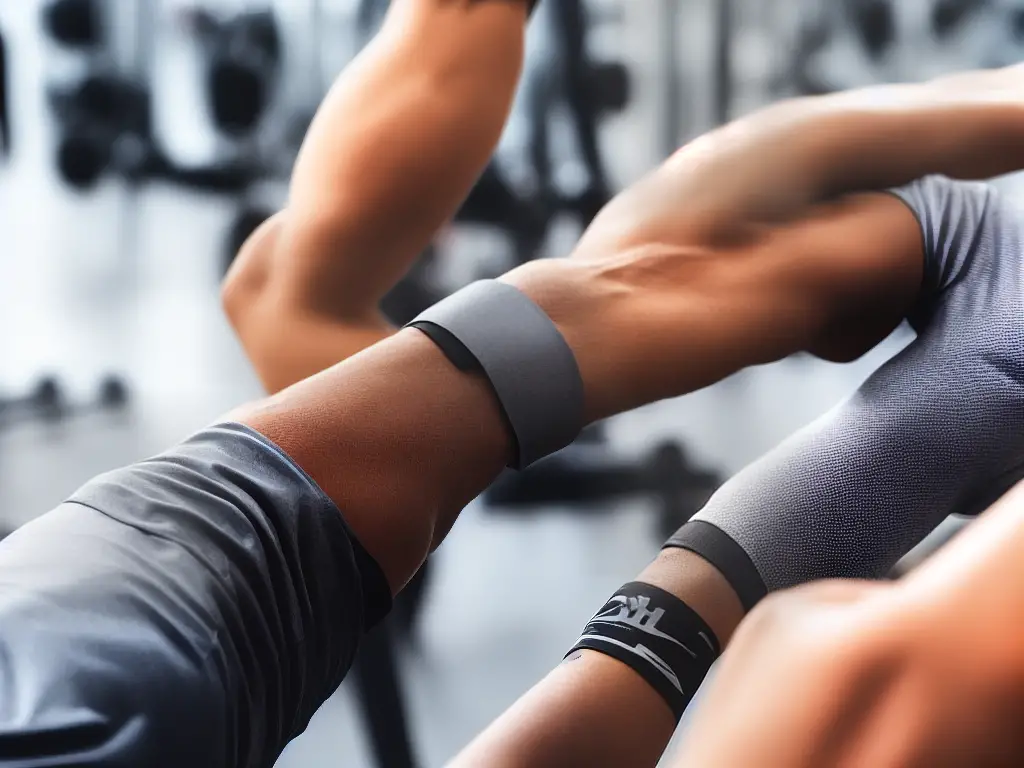
Tracking progress and setting goals
Developing your upper body strength is an essential component of a well-rounded fitness routine. Tracking your progress and setting goals will not only keep you motivated but also ensure that you are constantly challenging yourself and improving your strength in a systematic way. Follow these instructions to learn how to effectively track your progress, set realistic goals, and tailor your routine to achieve optimum results.
1. Understand your starting point:
Before beginning any strength training routine, it is crucial to evaluate your current fitness level and capabilities. Consult a physician or a certified fitness professional to ensure it is safe for you to begin upper body strength exercises.
2. Set SMART goals:
When setting goals for your upper body strength training, use the SMART criteria to make sure your goals are Specific, Measurable, Achievable, Relevant, and Time-bound. For example, “Increase my bench press weight by 20 pounds in 2 months.”
3. Choose appropriate exercises and routines:
Select exercises targeting various upper body muscles, including your chest, back, shoulders, and arms. Include a combination of compound exercises (such as push-ups, pull-ups, and rows) and isolation exercises (such as bicep curls and tricep extensions) in your routine. Consult a fitness professional if you need assistance in creating a well-balanced workout plan.
4. Track your performance:
Start a workout journal or use a fitness app to record the details of each workout session. Note down the exercises performed, number of sets and repetitions, and the weight lifted for each exercise. Include any additional variables, such as rest time between sets, to track your progress accurately.
5. Measure your progress:
Assess your progress regularly by retesting your strength using specific exercises, such as the bench press or pull-up. This can be performed every 4-6 weeks to determine if your current routine is effective in helping you reach your goals. Consider other measures of progress as well, such as muscle size, endurance, or reduction in body fat.
6. Adjust your routine as necessary:
As you progress with your strength training program, you may find that you need to increase the weight, sets, or repetitions to continue seeing improvements. Listen to your body and make adjustments accordingly, ensuring you allow for adequate recovery time between sessions. If your progress stalls, consider altering your training program, trying new exercises, or seeking advice from a fitness professional.
7. Stay consistent and patient:
Consistency is key when it comes to strength training. Stick to your workout routine and give your body the necessary time to recover and adapt. Remember that progress may not always be linear, and it is normal to experience plateaus or setbacks along the way. The key is to stay persistent, focused on your goals, and continue refining your approach.
8. Reward your achievements:
Celebrate milestones and accomplishments along your strength training journey. Treat yourself to new workout gear, take a rest day, or share your progress with friends and family. Not only does this keep you motivated and accountable, but it also reinforces the positive habits you have cultivated in pursuit of your fitness goals.
By following these guidelines, you can effectively track your progress and set achievable goals for your upper body strength. Stay consistent with your routine, measure your progress, and don’t be afraid to make adjustments as needed. With dedication and persistence, you will achieve your desired level of upper body strength and enjoy the many benefits associated with it.

Armed with the knowledge of upper body anatomy, proper exercise form, and various types of exercises, you are now equipped to embark on your journey towards improved upper body strength. Remember to balance your workout routine, prioritize rest and recovery, and consistently track your progress. With determination and dedication, you can achieve your fitness goals and build a strong, powerful upper body to enhance your overall well-being.